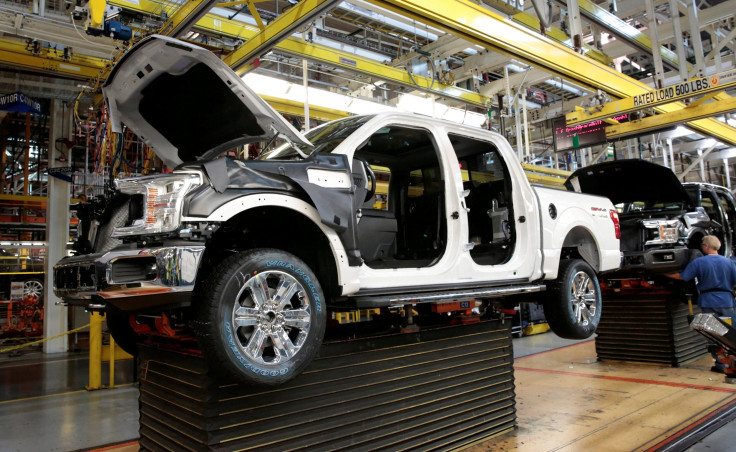Ford Motor Company Profit Slips 37% On China Woes

Ford Motor Company (NYSE:F) said it earned $991 million in net income in the third quarter, down 37 percent from the third quarter of 2017 largely because of weaker sales and higher costs in China. Revenue of $37.6 billion was up about $1.1 billion from a year ago, on an improved "mix" of products sold, particularly in North America.
This article originally appeared in The Motley Fool.
Ford made some small adjustments to its full-year guidance but maintained the revised full-year profit target that it issued in July.
The raw numbers

Ford's quarter in a nutshell
Ford has work to do, and the company knows that. Its operations in Europe, South America, and especially China all posted losses in the third quarter. All need new products and significant restructuring.
The good news is that those products are coming and the restructuring work has begun, though it's too early to say when those efforts will show results on the bottom line. In the meantime, other parts of Ford's business continued to do well: North America, Ford Credit, and Asia Pacific (outside China) all posted solid results.
How Ford's business units performed in the third quarter
Here's a look at how each of Ford's business segments performed. Note that all financial results in this section are reported on an EBIT basis, except as noted.
North America: Ford earned EBIT of $2 billion in North America, up from about $1.9 billion in the third quarter of 2017. Ford's U.S. sales fell 3.7 percent in the quarter, in large part because of a supplier fire that interrupted truck production earlier in the year. But Ford was still able to generate good results with its high-margin trucks and large SUVs, which helped keep earnings strong. Ford's EBIT margin in North America, a widely watched number, was 8.8 percent, roughly equal to a year ago.
South America: Ford lost $152 million in South America, $2 million worse than a year ago. Big gains on pricing were more than offset by costs related to inflation and unfavorable exchange-rate movements. CFO Bob Shanks said Ford is in the early stages of a major "redesign" of its business in South America, but he had no details and no timeline to share.
Europe: Ford lost $245 million in Europe, versus a loss of $53 million a year ago. The story here is not awful: Ford is in the midst of launching an all-new Focus in Europe; launch-related costs and limited supplies of the big-selling model were part of the story here, as were exchange-rate-related declines and weak markets in Turkey and Russia.
Middle East and Africa: Good news here, as Ford's small Middle East and Africa unit earned $47 million, up from a $56 million loss a year ago, despite a revenue decline driven by lower sales volumes. Costs are down, product "mix" improved, and pricing was strong.
Asia-Pacific: Ford's Asia-Pacific unit lost $208 million, a dramatic decline from a $314 million profit a year ago. Much of the story here is China, where Ford's sales were down 37 percent in the third quarter. That alone accounted for $480 million of the decline. Ford has a major restructuring under way in China, a high priority for CEO Jim Hackett, but it will probably take several quarters to show meaningful results.
Mobility: Ford's mobility segment, which includes its autonomous-vehicle effort and its Ford Smart Mobility initiatives, lost $196 million, versus a $72 million loss in the year-ago period. The larger loss represents increased investments -- an additional $58 million invested in Smart Mobility, and an additional $66 million in autonomous-vehicle development, versus the third quarter of 2017.
Ford Credit: Profit before tax for Ford's captive-financing arm was an impressive $678 million, its best quarterly result in over seven years and a $78 million increase from a year ago. Much of the gain was due to higher auction values for off-lease vehicles returned to Ford and to a good increase in volume. Lease penetration of 21 percent remains well below the industry average of 29 percent, and credit quality remains high. Good news all around.
Debt and liquidity
Ford ended the third quarter with $23.7 billion in cash available to its automotive business, down from $26.5 billion as of the end of 2017 but still an ample reserve. It had an additional $11 billion in available credit lines, for total automotive liquidity of $34.7 billion.
Against that, it had $15.3 billion in well-structured long-term debt attributable to its automotive business, down from $16.5 billion at the end of 2017.
Looking ahead: Ford's guidance
Ford made two minor updates to the revised guidance it issued after the second quarter. It now expects full-year results in South America to be about the same as 2017, where it had previously expected a slight improvement, and it now expects to pay an adjusted effective tax rate of about 10 percent, versus 13 percent in its earlier guidance.
Of note: Ford maintained its profit guidance. It still expects adjusted earnings per share for the full year to come in between $1.30 and $1.50. Through the first three quarters, Ford has earned $1 per share on that basis.
John Rosevear owns shares of Ford. The Motley Fool recommends Ford. The Motley Fool has a disclosure policy.





















